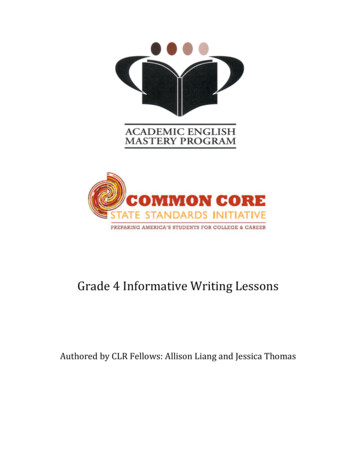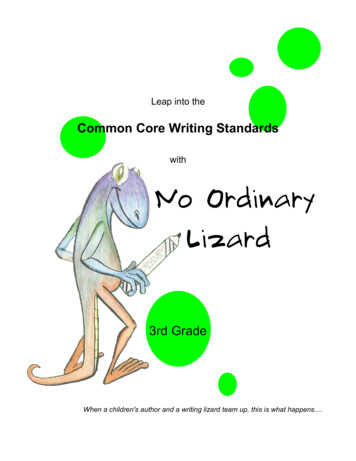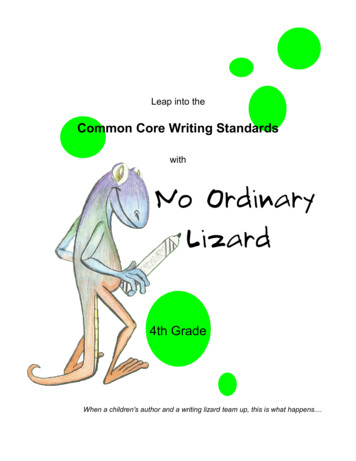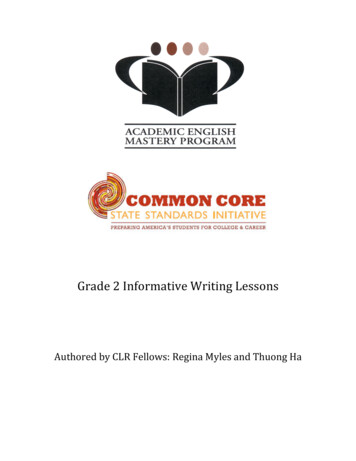
Transcription
Grade 4 Informative Writing LessonsAuthored by CLR Fellows: Allison Liang and Jessica Thomas
AY 1Informative Writing Pre-AssessmentCommon CoreObjective(s)CCSS-ELA.W.8. Recall relevant information from experiences or gather relevantinformation from print and digital sources; take notes, paraphrase, and categorizeInformation, and provide a list of sources.CCSS-ELA.W.2. Write informative/explanatory texts to examine a topic and convey ideasand information clearly.Essential Question“Big Idea”MELD Objective(s):What is Informative Writing?Utilizing MELDmethodologies to supportmastery of school languageand literacy.Access Strategy(ies) /ProtocolsIncorporated into thislessonMaterials / ResourcesInstructional Strategies:Intended Student Learning Outcomes:Student demonstrates proficient use of Standard English (SE) in written and oralform.§ Think Pair Share§ Whip Around§ Instructional Conversation§ Advanced Graphic Organizers§ InformativeWritingDay1PowerPoint§ InformativeWritingFlipBook§ “InformationChant”§ “Welcome to Los Angeles” – Writing TemplateLesson Sequence1. InteractiveRead- ,CA?§ theslides.§ Afterviewingtheslides,havestudentsThink- ‐Pair- geles?Whatwouldpeopleseeordothere?”2. Pre- int,Studentswillconductacold- inLosAngeles?Whatwouldpeopleseeordothere?”§ ecelookslike,orcontains.”§ ionanddiscussionprotocolsto“stop
ormative AssessmentDifferentiation:Common aboutinformationalwritingpresentedoneachslide.§ eyideasfromtheslides.6. ormativeWritingFlipBooks.§ itingFlipBooks.§ upInformationGame§ ationGame.§ Students participate in the chant by thinking of details for a given topic.Students will whip around to participate in categorizing information,relevant details, and by staying on topic.Students’ Flip Books can be used to assess students’ understanding of informational text.Teachers can use students’ writing samples to assess students’ abilities and needs, using thisinformation to guide their instruction throughout this unit of study.DAY 2 Informative WritingCCSS-ELA.W.8. Recall relevant information from experiences or gather relevant informationfrom print and digital sources; take notes, paraphrase, and categorize, information, and provide alist of sources.CCSS-ELA.RI 2 Determine the main idea of a text and explain how it is supported by keydetails; summarize the text.CCSS-ELA.SL.4.1 Engage effectively in a range of collaborative discussions (One on one, ingroups, and teacher led). With diverse partners on grade 4 topics and texts, building on others’ideas and expressing their own clearly.Essential Question“Big Idea”MELD Objective(s):Utilizing MELDmethodologies to supportmastery of school languageand literacy.Access Strategy(ies) /ProtocolsIncorporated into thisWhat is annotating text?How do I extract the main idea and details from Informational Text?Intended Student Learning Outcomes:Students will participate in a Collaborative Reading and note taking from a CesarChavez (Delores Huerta) Biography in order to take notes, and categorizeinformation into Topic and Supporting Facts. Use of Advanced Graphic OrganizersInstructional Conversations facilitated by purposeful use of Participation andDiscussion Protocols
essonMaterials / ResourcesInstructional Strategies: Academic Vocabulary Development1. Highlighters and Post-its2. Informational Text: Cesar Chavez “La Causa,” (additional resources foryou to chose from: Delores Huerta, and any Treasures Informational TextLeveled Readers)3. iPads, if students are accustomed to annotating in this way4. Supplemental Materials PowerPoint: Day 2Informational Writing Focus: Students will take notes from informational text to developa multiple paragraph informative essay.Lesson Sequence:Whole Group:1. Teacher will display the “Information Leveled Student Writing Sample,”(Suggested material: Refer to Lucy Calkins, Writing Pathways, Page 158 –159) or create your own “Mentor Text.” Then the teacher will introduce thebiography/informational text to the students and will inform the class of thewriting objectives. “Today, we will be reading about Cesar Chavez. We will betaking notes about facts that are important to us. Then we will use our informationto compose a multiple paragraph essay to inform our audience about Cesar Chavez.”2. Teacher reads the first two to three sentences of the first paragraph andmodels “Thinking Aloud” by asking out loud the question “Can I identify themain Idea from the text so far? I think the first sentence is the main idea. But let’skeep reading to make sure?”3. Teacher models annotating the first paragraph of a text and highlightsimportant main ideas and details using overhead projector. “I think this is animportant fact because.” “The author wanted readers to understand thisdetail because.”4. Use “Pick A Stick” as you select a student to read two to three sentences at atime to finish reading the rest of the article. Stop and discuss the text as awhole group. “What is the main idea in the second paragraph? What is the authortrying to inform us about the topic?” “Which sentences are details that support themain idea?”5. Students “Give one, Get One” to compare highlighted notes with a partner.Share the main idea and one interesting supporting fact you learned aboutCesar Chavez.6. Teacher discusses main idea and details and charts an example of how to use“Box and Bullets” to write the main idea and details from the first paragraphParticipation Protocol: Pick a StickDiscussion Protocol: Give One, Get OneSmall Group1. Teach “Put Your Two Cents In” Discussion Protocol:o Students will practice this new Discussion Protocol because it
rovides students with individual opportunities to state their ideas,but requires other participants to listen in to order to be able torespond to them.§ Break students into groups of four to practice this DiscussionProtocol.§ Distribute fake coins, or any other kind of “Talking Chip” forstudents to use as they practice this Discussion Protocol.Inform students that they will use this protocol to practice: MainIdea and details.2. Instruct students in groups to use the “Put Your Two Cents In”Discussion Protocol to write the main idea and details from the secondparagraph using their annotated highlighted text onto post-its., and support itwith reasons, as they answer posed questions.3. Students apply their post-its to categorize the Main Idea and Details from thetext onto the Boxes and Bullets work mat.4. Teacher uses “Pick a Stick” (With team #’s written on sticks) or “Roll ‘Em”to randomly select a team to orally present their Boxes and Bullets with theclass.o Students can be provided with sentence frames to scaffold theirspeaking and writing.Participation Protocol: Pick a Stick or Roll ‘EmIndependent:1. Students will use their teams’ Boxes and Bullets Advanced Graphic Organizer towrite a sentence stating the Main Idea and two sentences with the supporting details.Formative AssessmentTeacher assesses:1. Students’ annotated text using highlighters2. Students’ ability to write sentences with the main idea and details3. Speaking and Listening during small group completion of the Boxes and Bulletswork mat4. Oral participationCommon CoreObjective(s)DAY 3 Write and Informational Paragraph using NotesCCSS-ELA-W2b Develop the topic with facts, definitions, concrete details,quotations, or other information and examples related to the topic.Essential Question“Big Idea”MELD Objective(s):CCSS-ELA-W2.4 Produce clear and coherent writing (including multipleparagraphs texts) in which the development and organization are appropriate to task,purpose, and audience.How do I develop the topic in my writing with concrete details?How do I develop and organize my ideas to write a paragraph?Intended Student Learning Outcomes:Utilizing MELD
ethodologies to supportmastery of school languageand literacy.Access Strategy(ies) /ProtocolsIncorporated into thislessonMaterials / ResourcesInstructional Strategies:Topicalization – Sentence Structure: Students will understand how to use their Boxand Bullets, Advanced Graphic Organizer to write an informational paragraph.Use of Advanced Graphic OrganizerInstructional Conversation facilitated by purposeful use of Participation andDiscussion Protocols Academic Vocabulary Development Communal & Cooperative Groups1. Topic/Idea Cards2. Topic/Idea Directions3. Informational Text - (Cesar Chavez - “La Causa,” Delores HuertaBiography, etc.)4. Notes from Informational Text5. Completed Box and Bullets6. iPads, if students are accustomed to writing essays in this way7. Supplemental Materials PowerPoint: Day 3Informational Writing Focus: Students will construct paragraphs that are organized toprovide facts and supporting details about a given topic. Lesson Sequence:Whole Group:1. The class participates in a “Topic Idea” GameThe Teacher reviews directions for the gameThe Teacher distributes one “Topic Idea” Card to each student: Read your card 3 times Find others with cards that fit with yours Stand or sit together in a circle One at a time read your card out loud Decide as a group what the topic is Come up with possible ideas as the details point to Decide on three possible topic sentences2. The teacher says, “Over the past few days we have been learning how toextract information from the text to write notes. Our notes have helped usorganize our information into main ideas/topics, supporting details andquotes. Today we will use all of our collected research to write aintroduction paragraph.”3. The teacher charts and models how to create a paragraph about the topicusing a topic sentence, notes/examples from the text, details, and examplesfrom the collected research.Title:Question:Topic Sentence:Supporting Detail #1:Supporting Detail #2:
ndividual Activity:Students should complete an informational paragraph using the Box andBullets graphic organizers completed on Day 2.Grammar Mini-Lesson (10 – 15 minutes)You can use the California Treasures’ Writing and Grammar Intervention Guide’sSection on Linguistic Differences to find the lessons that can be used to help SELsunderstand how to compare and contrast the way a particular grammar rule is usedin Home Language and School Language Formative AssessmentDifferentiationCommon CoreObjective(s)Use the sentences collected on Day 2 to guide the spelling, punctuation,capitalization, and grammar rules you’ll address during your grammarmini-lesson.Students’ individual paragraphs. Use these sentences to determine the topic for tomorrow’sGrammar Mini-Lesson.Some students may need to focus on writing one paragraph, while others may be ready tomove on to multiple paragraphs.DAY 4 Informational Writing using QuotationsCCSS-ELA.RI. 8 Explain how an author uses reasons andevidence to support particular points in a text.CCSS-ELA.W.2b Develop the topic with facts definitions, concrete details, quotations, or otherinformation and examples related to the topic.Essential Question“Big Idea”MELD Objective(s):Utilizing MELDmethodologies to supportmastery of school languageand literacy.How do I use quotes to support the topic sentence?How do I use correct punctuation when quoting text?Intended Student Learning Outcomes:Sentence Structure: TopicalizationIntended Student Outcomes:Students will understand how to develop the supporting detail sentences using quotes.Students will practice extracting key ideas from a text in order to use the correct punctuationwhen quoting.Access Strategy(ies) /ProtocolsIncorporated into thislessonMaterials / Resources Instructional ConversationsCooperative and Communal Learning EnvironmentMaking Cultural ConnectionsAdvanced Graphic Organizers al TextBox and Bullets work mat noteSentence StripsPunctuation cut-outs (“quotation marks”, comma, and period.)”Cite Information from Text Using Quotations” work matiPads if used regularly
nstructional Strategies:Informational Writing Focus: Students will use the “Quotation Starters” work matto cite information from the text and correctly use punctuation.Lesson Sequence:Whole Group1. Teacher will review the main idea and details from the previous lesson.2. Teacher will model how to use annotations from the previous lesson to extract aquote.3. Teacher will display chart of examples of sentence/quote“Quote Starters.”The writer said, “ .”According to the text, “ .”In this example, “ .”The passage told us, “ .”The author suggested, “ .”4. Teacher will use the “Pick a Stick” Protocol to choose students to assist inextracting information from the article and notes from the previous lesson.Small Groups:1. Students work in small groups to write quotation sentence starters andextracted information from the text on sentence strips.2. Students use punctuation cutouts to correctly paste the punctuation onsentence strips.Independent Work:1. Students complete the “Cite Information from Text Using Quotations” Workmat.2. Students participate in a “Give one, Get one” Participation Protocol to checkfor understanding.Formative AssessmentTeacher Assesses:1. Dictation: Teacher reads 3 sentences with quotations.2. Punctuation: How well the students correctly place the quotation marks, commas,and period.DifferentiationStudents increase academic vocabulary using the Personal Thesaurus to find synonyms forthe words article and said.Common CoreObjective(s)DAY 5 Writing an Informational Multiple Paragraph EssayCCSS-ELA-W.4 Produce clear and coherent writing (Including multiple paragraph texts) inwhich the development and organization are appropriate to task, purpose, and audience.CCSS-ELA-W.2b Develop the topic with facts, definitions, concrete details, quotations, orother information and examples related to the topic.
CSS-ELA W.2c. Link ideas within categories of informational using words and phrases(e.g., another, for example, also, because).CCSS-ELA-W.2e Provide a concluding statement or section related to the information orexplanation presented.CCSS-ELA-L.6 Acquire and use accurately grade-level appropriate general academic anddomain-specific words and phrases.Essential Question“Big Idea”MELD Objective(s):Utilizing MELDmethodologies to supportmastery of school languageand literacy.Access Strategy(ies) /ProtocolsIncorporated into thislessonMaterials / ResourcesInstructional Strategies:How do I write a multiple paragraph text?Intended Student Learning Outcomes:Sentence Structure: TopicalizationStudents will use their Advanced Graphic Organizers to write a Multiple ParagraphEssay. 1.2.3.4.5.6.Use of Advanced Graphic OrganizerInstructional Conversation facilitated by purposeful use of Participation andDiscussion ProtocolsAcademic Vocabulary DevelopmentInformative Writing Flip BookAnnotated notesBox and BulletsInformative Writing TemplateCite Informational Text Using Quotations Work MatTransition Words Poster/Chart7. iPads, if students are accustomed to annotating text in this wayInformational Writing Focus: Students will construct an organized multiple paragraphessays that provides facts and supporting details about a given topic.Lesson Sequence:Whole Group1. Teacher asks students to review their notes from the previous informationalwriting lessons.2. Teacher asks students to work with a partner and “Think- Pair-Share” (TPS)the elements of an Informational Writing Text.3. Teacher uses “Pick – a – Stick” Discussion Protocol to review the elementsof a paragraph essay.4. Teacher reviews using quotes to support the topic sentence.5. Teacher reviews the transition words Work Mat.6. Teacher models using the Informational Text Advanced Graphic Organizerto input information from collected notes.7. Teacher reviews introduction paragraph from Day 3.8. Teacher says;“Today we will begin writing a Multiple Paragraph text. We will use ourSupporting Details from our Introduction Paragraph to create 2 new TopicSentences additional paragraphs. We will use the Advanced Graphic Organizerto organize our ideas. We will add Transition Words to link ideas. We will
rite a Concluding Paragraph to restate our introduction paragraph.”9. The teacher models and charts an example using the Advanced GraphicOrganizer as a pendent work:1. Students will write a question/statement to entice audience onto AdvancedGraphic Organizer.2. Students write the Topic Sentence, Quote and Supporting Details on theAdvanced Graphic Organizer to support Facts from the introductoryparagraph.3. Students add Transition words.4. Over the next 3 days, students confer with the teacher and classmates torevise and edit the structure of the Informative Writing.5. Students will publish their Multiple Paragraphs using the computer.Grammar Mini-Lesson (10 – 15 minutes)RevisingFormative AssessmentDifferentiationGrammar Mini Lesson:Sentence Lifting with Verbso Teacher copies small sections of students’ writing and models use of thePersonal Thesaurus to strengthen verb usage.o Ex: “Cesar Chavez fought for Civil Rights.”o Students find synonyms for the base word “fight”o Students revise sentences – “Cesar Chavez contested Civil Rights”o Students will identify the verb from 2 or more of their sentences in orderto acquire and accurately use general academic and domain specificwords.Teacher Assesses: Progress in the structure of the Multiple Paragraph Essay Students’ progress writing clear and coherent topic sentences and supportingdetails Students’ progress linking ideas with the use of transition wordsStudents’ progress writing a concluding statement or paragraphYou may need to use Enrichment materials provided by Treasures Writing and Grammar forGrammar Mini-Lesson.
3. Informational Text - (Cesar Chavez - "La Causa," Delores Huerta Biography, etc.) 4. Notes from Informational Text 5. Completed Box and Bullets 6. iPads, if students are accustomed to writing essays in this way 7. Supplemental Materials PowerPoint: Day 3 Instructional Strategies:











